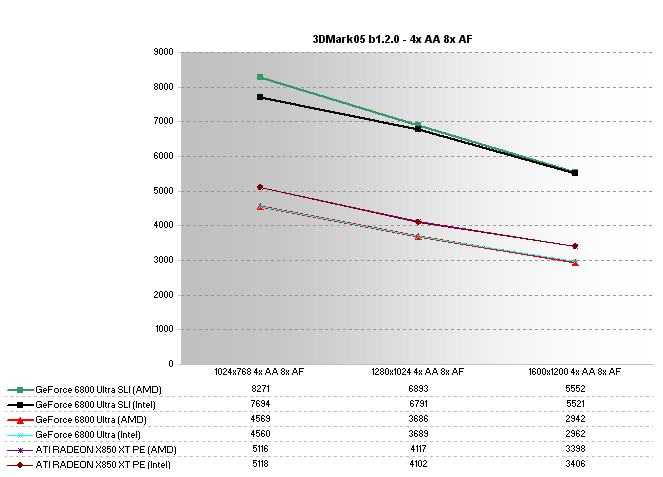Gaming performance - 3DMark05
Gaming benchmarks have been conducted a little differently, in lieu of the MSI P4N Diamond's SLI capability. Right now, if you're looking to be an SLI-capable chipset, the choice rests with NVIDIA, be it on S939 for AMD or now, as per P4N Diamond, for LGA775 CPUs. Intel's launched its own SLI LGA775 chipset, the i955X Express, but retail models aren't available yet. In view of this, the P4N Diamond's graphics performance was directly compared against an AMD-based nForce4 SLI board, ABIT's AN8-SLI. Both boards were run with a single ATI RADEON X850 XT PE 256MB card and also a single NVIDIA GeForce 6800 Ultra. Twin 6800 Ultras were then SLI'd on both boards for top-end gaming performance. The results were interesting...
There's three sets of lines you need to look out for, which correspond to the same card(s) on each board. Now look at the 3DMark05 results for both P4N Diamond (Intel) and AN8-SLI (AMD) when running single cards, be it GeForce 6800 Ultra or 'X850 XT PE; they're largely the same. The GPU-heavy nature of the benchmark takes away the performance edge that an AMD Athlon 64 FX-53 would give over an Intel Pentium 4 660. Now look at the results of the SLI'd Ultras, the green and black lines. Note how far behind the Intel setup (MSI P4N Diamond) is at lower resolutions? It seems to be a case of the cards' huge combined shading and fillrate power not being helped on enough by a P4 660. The gap closes as the resolution, and by inference the GPU load, increases. Food for thought when choosing SLI.

Here's the same test but with 4x AntiAliasing and 8x Anisotropic Filtering. Single cards perform almost identically on both platforms, but there's still a performance gap, until the highest setting, between AMD and Intel nForce4 SLI.









